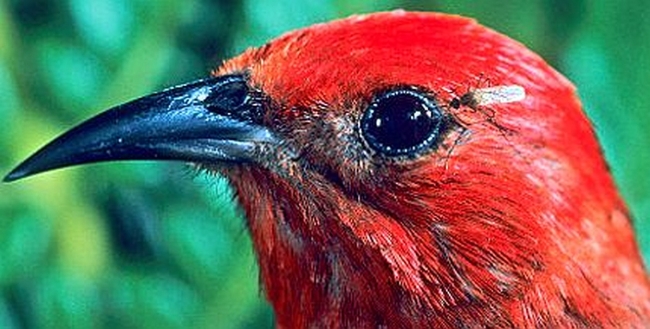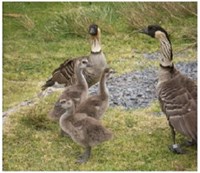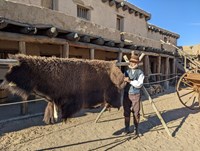- Lesson Plan (15)
- Other Education Materials (4)
- Distance Learning (2)
- Student Activities (2)
- Field Trips (1)
- Haleakalā National Park (6)
- Everglades National Park (4)
- George Washington Birthplace National Monument (3)
- Florissant Fossil Beds National Monument (2)
- Agate Fossil Beds National Monument (1)
- Andersonville National Historic Site (1)
- Badlands National Park (1)
- Bent's Old Fort National Historic Site (1)
- Buffalo National River (1)
- Show More ...
- Science (17)
- Social Studies (8)
- Math (2)
- Literacy and Language Arts (1)
Showing 24 results for Extinct ...
Autobiographies of Extinct and Endangered Species
- Type: Lesson Plan
- Grade Levels: Middle School: Sixth Grade through Eighth Grade
This lesson is about why species become endangered or extinct. Students will do a case study of one extinct and one endangered species. The two biggest threats to a species survival are invasive species and habitat loss. Students will learn what an invasive species is and see visuals of habitat loss on Maui. Without intervention and management, these endangered species could disappear within the students’ lifetime.
“Survival: Risky Business” Wildlife 4-6 Grade
- Type: Lesson Plan
- Grade Levels: Upper Elementary: Third Grade through Fifth Grade
Students will receive an endangered or extinct mystery animal card taped to their backs. They must use critical thinking skills to ask the right questions and discover the identity of their mystery animal. They will discuss what it means to be extinct or endangered and ways they can help those animals that are threatened with extinction.
What's for Dinner?
“Going… Going… Gone!” Water: 4-6 Grade
Buffalo Caves and Karst
"Food Chain Mobile" Everglades ABCs: 2nd Grade
Victory from Within: The American Prisoner of War Curriculum
- Type: Other Education Materials
- Grade Levels: Middle School: Sixth Grade through Eighth Grade
Educating young people about the sacrifices made by American prisoners of war (POWs) is a shared goal of the Friends of Andersonville, the American Ex-Prisoners of War, the Korean War Ex-POW Association, Nam-POW, and the National Parks Service. The Curriculum is designed to accompany the traveling exhibit, but it can also be utilized with a visit to the National Prisoner of War Museum at Andersonville National Historic Site or as a standalone curriculum.
When George Washington Was a Child
You Can Be Like George Washington Education Program
"Going, Going, Gone" Don't Let It Loose: 5-8th Grade
- Type: Lesson Plan
- Grade Levels: Middle School: Sixth Grade through Eighth Grade
Mosquito Population Control
- Type: Lesson Plan
- Grade Levels: High School: Ninth Grade through Twelfth Grade
How Most of the Plantation Lived: Slavery at the Washington's Farm
- Type: Other Education Materials
- Grade Levels: Upper Elementary: Third Grade through Fifth Grade
Geologic Timeline
- Type: Lesson Plan
- Grade Levels: Upper Elementary: Third Grade through Fifth Grade
Upper Piedmont Wildlife Habitat Prior to 1781
- Type: Student Activities
- Grade Levels: Upper Elementary: Third Grade through Fifth Grade
To have students define what kind of habitat an animal would have needed to survive in the upper Piedmont of the Carolinas prior to the Battle of Cowpens. Students will describe elements that contributed to the animal’s extinction from the area
William's Wheel of Fortune Lesson Plan
- Type: Lesson Plan
- Grade Levels: Upper Elementary: Third Grade through Fifth Grade
Life Time Line
- Type: Lesson Plan
- Grade Levels: Upper Elementary: Third Grade through Fifth Grade
Students will be able to visualize the times of important evolutionary events in relation to geological and cultural history. Students will be able to name some of the animals that became extinct at Craters of the Moon. Students will use their imaginations to forecast future events and designate them on a timeline.
- Type: Lesson Plan
- Grade Levels: Upper Elementary: Third Grade through Fifth Grade
This lesson introduces students to hot spot theory and how it relates to plate tectonics. It also compares and contrasts composite and shield volcanoes and introduces students to the theory behind the formation of the Hawaiian Islands. Students will learn how to classify Hawaiian volcanoes according to their activity and location as active, dormant and extinct.
Bison by the Numbers
- Type: Student Activities
- Grade Levels: Upper Elementary: Third Grade through Fifth Grade
The American bison was an important species to Native Americans on the Great Plains of North America. However, as settlers moved west during the nineteen century, the population numbers dramatically dropped from overhunting. In this exercise, students will learn graphing skills while learning about this species that almost went extinct.
Adaptations Unit Field Trip
- Type: Field Trips
- Grade Levels: Upper Elementary: Third Grade through Fifth Grade
Many of Haleakalā’s forest birds have evolved and adapted over time with specific niches in their habitat. Explore how these adaptations are important to the health and stability of native habitats. Learn about the threats to these rare and endemic forest birds and what Haleakalā National Park is doing to protect them from extinction.



















